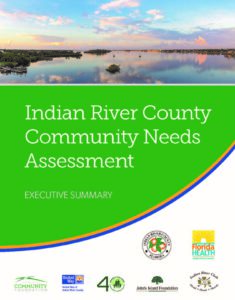Community Needs Assessment says some IRC residents' lives can be improved through private, public resources
INDIAN RIVER COUNTY — June 22, 2020, written by Janet Begley.
One-half of the county’s residents are living in poverty or at least one paycheck away from it.
And at least 1% of the county’s total population in 2019 was homeless, with more than 150 children not having a permanent residence.
These statistics are identified in a year-long Community Needs Assessment that brought together government, community, philanthropic and nonprofit leaders to identify ways to improve the lives of residents.
The 80-page report points out the need to devote long-term investment of private and public resources if lasting change is expected.
The document points out current and anticipated conditions that need urgent attention in the county, and serves as a starting point for conversations about equity, said Jeff Pickering, president and CEO of the Indian River Community Foundation that helped coordinate the survey.
“Too many of our neighbors work in jobs that do not pay enough to afford safe, quality housing,” said Pickering. “Too many of our children are not prepared for kindergarten, fail to read on grade level by 3rd grade and do not finish high school."
He said too many county teens engage in risky behaviors like drinking alcohol and vaping; and too many residents lack affordable medical, dental and mental health care.
"Too many of our community’s low-income seniors live alone, in substandard housing without adequate social interaction,” he said.
While Indian River County is one of the top 10 richest counties in Florida, it also has the 10th largest income gap between the top 1% and the bottom 99% of earners out of 3,061 counties nationwide, according to the document.
Annually, the top 1% earn an average of $2.9 million and the bottom 99% earn $43,373, far below the $63,145 a family of four needs to live in the county.
In 2019, typical jobs for low-income individuals and families were service-oriented and paid lower than other communities in Florida. This includes housekeepers, waiters, landscapers and laborers. It also includes many of the county’s 3,000 teachers who earn an average annual salary of $43,094.
“I believe the Community Needs Assessment provides confirmation of some important facts about our community’s population,” said Picketing. “We have a rapidly growing senior population, which includes a large percentage of low-income seniors who live alone with limited access to social and other services. We have a rapidly diversifying population, which includes a growing number of Hispanic and African-American households. And we have a persistent wealth gap that is continuing to widen.”
But the news is not all bad.
The needs assessment points out ways the county made progress over the past decade, particularly before the recent pandemic, according to United Way of Indian River County CEO Michael Kint.
“Since much of the work was completed prior to any widespread awareness of COVID-19, the report’s findings are likely to be overly optimistic, at least for the immediate future,” said Kint. “That said, we are proud of the progress that is being made in certain areas. Infant mortality has decreased, early childhood education is improving and access to mental health and substance abuse recovery services has increased as a direct result of community collaborations.”
Over the next year, the community needs assessment will be used to identify areas where time and money could benefit organizations and projects that are already proving to make a difference.
Community leaders and philanthropists will use the report to develop collaborative efforts that can address some of the more persistent challenges.
For more information about the Community Needs Assessment, contact Indian River Community Foundation at 772-492-1407 or the United Way of Indian River County at 772-567-8900. Digital copies of the executive summary and full report may also be found at www.ircommunityfoundation.org and www.unitedwayirc.org.
